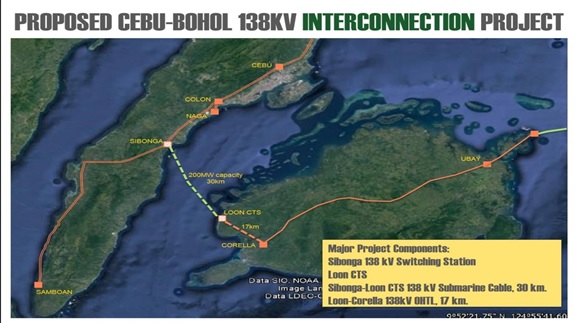The Cebu-Bohol power link is now pursued to be done much earlier than expected over the next three years, bearing fruit for Gov. Edgar Chatto’s lobby amid fearless forecast of Bohol’s load growth to get faster.
The interconnection from Sibonga in Cebu to Loon in Bohol can be completed in a new target period, possibly by December of 2020, according to the National Grid Corporation of the Philippines (NGCP).
Pre-construction activities are to start in July while a provisional authority from the Energy Regulatory Commission (ERC) can just follow.
The most proximate implementation time frame highlighted the project status presentation by the NGCP to the Bohol media during a power forum at the Metro Centre here on Thursday.
The forum had Winifred Paguia, NGCP head for engineering in the Visayas; Buena Amor Capua, senior engineer of the Visayas transmission system planning division; and Nelson Bautista, head for regional communications.
It was also attended by Ma. Rosette Martinez, NGCP regional corporate communication and public affairs officer, and Octavio Briones, head for operations and maintenance covering the Cebu-Bohol area.
The NGCP officially informed Chatto of the 2020 completion target and pre-construction activities that will begin in July. Â
The governor thanked the NGCP for finally “categorically making the commitment.â€
 “We do need the new interconnection to provide power transmission redundancy and not just rely on the existing system from Leyte,†the governor said.
At the forum with the media, Capua identified barangay Moto Sur in Loon as one possible landing site for the 30-kilometer submarine cable that transmits 138 kilovolts (kv) of power from Sibonga in Cebu.
On Wednesday, Chatto convened the Bohol Energy Advisory Group (BEDAG) to coordinate actions on concerns of Cebu and Bohol local government units (LGUs) hosting the power link facilities.
The NGCP is currently preparing the ERC documents for the provisional authority, which allows the pre-construction activities to proceed.
The activities include the hydrographic survey for the submarine cable, acquisition of landing site, and overhead transmission line route.   Â
Based on the NGCP forecast, Bohol’s power load growth is expected to get “faster†with the completion in 2018 of the new Bohol airport in Panglao, which will “boost tourism and commercial industries.â€Â
Bohol’s present peak load demand of over 70 megawatts (mw) has been projected to reach past the 90mw mark in 2020, according to the NGCP.
Chatto would even want the Cebu-Bohol interconnection to happen as earlier as 2019, again citing the “experiences†with the Leyte interconnection as the main source and lone external transmitter of power to Bohol.
ISLAND-BASEDÂ FOR LONG TERM
 The early connection from Cebu can well indicate an earlier Bohol island-based energy generation plant, too, which is for long term, Chatto said.
Pursuant to the “one Bohol power†vision, the three electric distribution utilities (DUs) in the province will negotiate as one and purchase power in bulk from a single source, which can then be the island-based power plant.
The DUs refer to the two Bohol Electric Cooperatives (BOHECO I and II) and Bohol Light Company, Inc. (BLCI).
The three have existing bulk power supply contracts which will expire in December of 2003 and, at the BEDAG meeting, they finalized their power demand and supply projections.
They will enter into a new contract but on a condition that their supply is to be sourced from a big source of electricity generated right here in Bohol.
The three DUs will bid as one group through the “One Bohol Power Aggregation†or OBPA agreement, which draft was presented to the BEDAG, and no longer contracting individually.
The aggregation has apparently made this early a number of energy producers more than eager to invest and build a large-scale energy generation facility in Bohol.
At the BEDAG, of which the DUs are among the members, four critical considerations have been identified as a basis for accepting the most competent and competitive island-based power producer.
The best project proposal is considered according to environmental impact, cost, efficiency and sustainability.
Chaired by the governor himself, what BEDAG has longed for, notably the Cebu-Bohol interconnection and one Bohol power system, are becoming a reality, according to its members.
More power investors presented their intents at the BEDAG, which also has representatives from the Department of Energy and even local universities and colleges offering electrical engineering course.
USAID-COMPETE consultant Prof. Wali del Mundo and COMPETE infrastructure team leader Arlene Donaire likewise attended the BEDAG meeting, which presentations included the Bohol power ecozone.
The Cebu-Bohol interconnection has itself excited the power developers because any excess electricity generated from the plants they put up here can be transmitted through the interconnection for sale outside. (Ven rebo Arigo)

